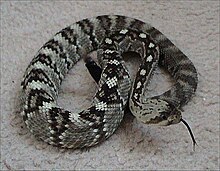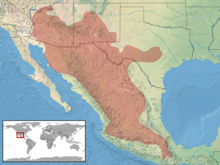Crotalus molossus
| Crotalus molossus | |
|---|---|
 |
|
| Scientific classification | |
| Kingdom: | Animalia |
| Phylum: | Chordata |
| Class: | Reptilia |
| Order: | Squamata |
| Suborder: | Serpentes |
| Family: | Viperidae |
| Genus: | Crotalus |
| Species: | C. molossus |
| Binomial name | |
|
Crotalus molossus Baird & Girard, 1853 |
|
 |
|
| Synonyms | |
Crotalus molossus is a venomous pit viper species found in the southwestern United States and Mexico. Four subspecies are currently recognized, including the nominate subspecies described here.
This medium-sized species averages from 76 to 107 cm (30 to 42 in) in length. Large specimens are usually not much more than 100 cm (39 in) long, although lengths of 125.0 cm (49.2 in) (Gloyd, 1940), 125.7 cm (49.5 in) (Klauber, 1972), and 129.5 cm (51.0 in) (Shaw & Campbell, 1974) have been reported. The females tend to be larger than the males.
They range in color from yellows and olive greens to browns and black. As their name implies, one of their most distinguishing features is, despite variations in body color, the tail scales are entirely black. Often, this rattlesnake has a black band across its eyes and diagonally down to the corners of its mouth, forming a sort of facial 'mask'.
Like other rattlesnakes, C. molossus has a rattle composed of keratin on the end of its tail. Each time the snake sheds its skin, a new segment is added to the rattle. They can shed their skin several times a year, and the rattle is fairly fragile and can be broken, so the length of a rattlesnake's rattle is not an accurate measure of its age, unless the terminal button is intact.
It is found in the southwestern United States in Arizona, New Mexico and west and central Texas, and Mexico as far south as Oaxaca. Also it is found in the Gulf of California on San Estéban and Tiburón Islands. The distribution reaches a maximum elevation of 2930 m. Although it has been recorded being seen at as high of an altitude as 6900 feet at the McDonald Observatory in the Davis Mountains of West Texas. The type locality given is "Fort Webster, St. Rita del Cobre, N. Mex." (Fort Webster, Santa Rita del Cobre, Grant County, New Mexico, USA).
...
Wikipedia

